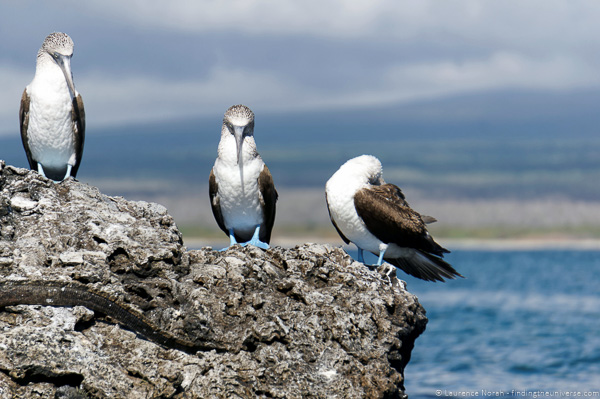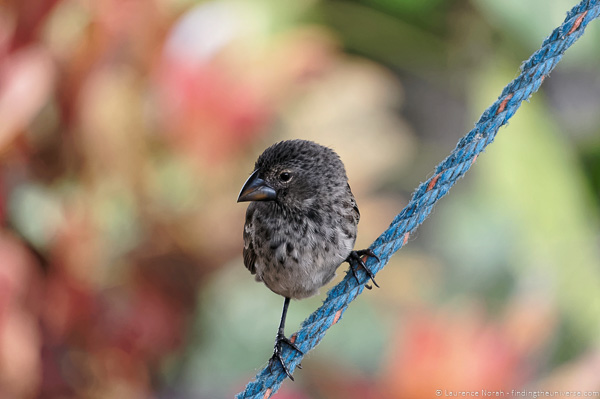Wildlife photography is one of those types of photography where gear can really make a difference in the shots you are able to achieve, particularly if you’re heading out on safari or somewhere exotic like the Galapagos.

Learn how to pick the best lenses for wildlife photography so you can achieve shots like this one of blue-footed boobies in the Galapagos.
All photos in this post by the author, Laurence Norah. See more at Finding the Universe.
What to look for in a wildlife photography lens
Focal length
The key characteristic to look for in a lens is the ability to get closer to the wildlife. Some animals are shy and won’t let humans come close. This means you want a lens that offers a lot of magnification — those with a longer focal length.
A longer focal length lets you get subjects that are far away to fill the frame. For wildlife photography, you are looking at focal lengths in the region of 150mm to 600mm — particularly if you are into shooting birds, which are often small subjects to start with!
Wide aperture
The other challenge wildlife photographer’s face is that of light. Wildlife is often active around dusk and dawn, when there is less light available. This means you need lenses that are capable of letting a lot of light in, with apertures of f/4.0 or wider. A combination of a wide aperture and a long focal length will result in somewhat expensive lenses, so in this post I’ll look at a variety of options at different budgets to give you an idea of what is out there.
Of course, not all wildlife is far away, and you can achieve some great results with lenses that are traditionally used for portrait work, such as a fast 50mm, 85mm or 130mm prime lens, or something like a 70-200 f/2.8 zoom lens. These focal lengths won’t let you shoot far away subjects very well, but if you know your subject is likely to be close, then you can get some wonderful close-up portraits. When I was shooting in the Galapagos, the wildlife often came so close that I had to use a wide angle lens to get everything in shot, such as with this frigate bird, which I shot at 17mm as he flew by, wingtips brushing my face!

So, what is the best lens for wildlife photography?
Canon EF 600mm f/4 L IS 2
This lens is pretty much the gold standard of the Canon lenses for wildlife photography. For a 600mm focal length, that f/4 aperture is huge, meaning the lens lets plenty of light in. It’s also image stabilized, although a lens of this size and weight is really going to need a tripod. This will run you about $12,000, so this one is really only if you are both incredibly serious about your photography and need to get close-up shots of far-away subjects consistently.
Canon EF 70-200 f/2.8 L IS 2
This is an incredible Canon lens, usually used for wedding or other event photography work. The focal length isn’t quite as useful for wildlife that is far away, but if you think you’re going to be able to get closer to your subjects, this lens will work just fine and produce fantastically sharp results. You can also add a teleconverter to this lens to increase the focal length if you want more reach.
This lens performs admirably in low-light conditions thanks to that huge f/2.8 aperture, which lets a lot of light in across all the focal lengths this lens offers. This versatile lens is recommended if wildlife photography is something you like to dabble in, along with other photography styles. It’s around $2,000, and there’s a Nikon equivalent. You can also pick up slightly cheaper options available from third party manufacturers including Sigma and Tamron, which also come in Nikon mount variants.
Nikon 70-300mm f/4.5-5.6G VR OR Canon EF 70-300mm f/4-5.6L IS USM Lens
These two lenses from the current leading DSLR manufacturers are the best option if you are on a tighter budget — both are available for around $650. Both offer a reasonable focal length (particularly on a crop sensor, which will extend that focal reach a good amount), image stabilization and reasonably fast apertures.
Of course, there are some tradeoffs when you spend less money: These lenses’ maximum aperture reduces as you increase the focal length, although the reduced cost, weight and size of these lenses make them far more accessible to the majority of users out there.

Sigma OR Tamron 150-600mm f/5 – 6.3mm Lens
Both Sigma and Tamron offer relatively affordable (around $1,000) telephoto zoom lenses that go from 150mm right out to 600mm, with an aperture that varies from f/5 at the wide end to f/6.3 at higher focal lengths.
These lenses offer a remarkable range of focal lengths, perfect for wildlife photography, and the price is very reasonable for what you get. There are some minor differences between these lenses, so I would advise reading reviews on each individual lens and trying them out in person before deciding which is best for you.
Canon 16-35 f/2.8 or Nikon 17-35 f/2.8
OK, it’s a slight anomaly to include a wide-angle lens in a wildlife photography lens round-up, but sometimes you want to achieve a different perspective.
If you can get really close to an animal (best tried with the less ferocious ones), then you might be able to snag some really unique shots with a wide-angle lens, offering a perspective that’s different from the norm. These two lenses are the best all round wide-angle lenses from their respective manufacturers at the moment, offering excellent performance and a lovely wide aperture. Plus, once you’re done with the wildlife, they’ll do wonderfully for architecture and landscape work as well.


Share tips, start a discussion or ask one of our experts or other students a question.
No Responses to “What Are the Best Lenses for Wildlife Photography?”